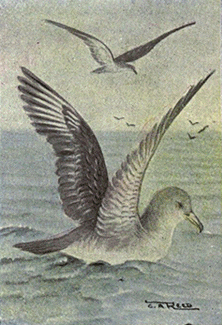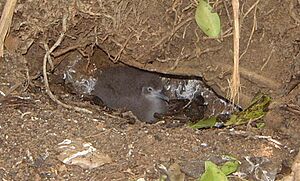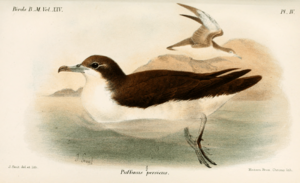Sargasso shearwater facts for kids
Quick facts for kids Sargasso shearwater |
|
|---|---|
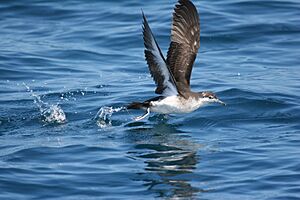 |
|
| off Cape Hatteras, North Carolina, USA. | |
| Conservation status | |
| Scientific classification | |
| Genus: |
Puffinus
|
| Species: |
lherminieri
|
| Subspecies | |
|
1-2, but see text |
|
| Synonyms | |
|
Puffinus assimilis lherminieri Lesson, 1839 |
|
The Sargasso shearwater (Puffinus lherminieri) is a small tropical seabird. It belongs to the petrel family. This bird is special because it is the only shearwater that mainly nests in the Caribbean. When it's not breeding, it flies all over the western Atlantic Ocean. Its scientific name honors a French scientist named Félix Louis L'Herminier.
This bird used to be part of a larger group called "Audubon's shearwater." But now, scientists have separated this group into many different species. These include the Sargasso shearwater, tropical shearwater, Boyd's shearwater, Barolo shearwater, Bannerman's shearwater, and Persian shearwater. These small seabirds look very similar, making them hard to tell apart. Scientists are still working to figure out their exact relationships.
Contents
What Does a Sargasso Shearwater Look Like?
The Sargasso shearwater is about 30 cm (12 inches) long. This is about half the size of a greater shearwater. It usually weighs around 170 grams (6 ounces). Some birds might be a bit bigger or smaller. Their wings can spread out from 64 to 72 cm (25 to 28 inches). Their tail is about 8.5 cm (3.3 inches) long.
These birds are mostly blackish-brown on top. Their bellies and the lower part of their heads are white. Their eyes are dark. Their feet are a dull pink with black parts and black toenails. Their beaks are grey, darker at the tip, and have a pinkish tint.
Both male and female Sargasso shearwaters look the same. Young birds look like the adults. Baby birds are covered in soft, grey down feathers on top and whitish feathers on their bellies.
How to Tell Them Apart from Other Birds
It can be tricky to tell the Sargasso shearwater apart from the Manx shearwater. The Manx shearwater has white feathers under its tail and a longer beak. Other similar birds usually live in different areas. The little shearwater might sometimes be found in the same waters. It has more white on its face and under its wings. It also has a smaller beak and grayish-blue feet.
These birds make twittering and mewing sounds. You often hear these sounds only at night in their nesting areas.
Where Do Sargasso Shearwaters Live and What Do They Eat?
The Sargasso shearwater mainly breeds on islands in the Caribbean and the Lucayan Archipelago. When they are not breeding, they fly across the northwestern Atlantic Ocean. They especially like areas near the Gulf Stream and the Sargasso Sea.
These birds can live in different ocean environments. You can find them far out at sea, closer to shore, and even near the coast. They have many ways to find food. They often dive into the water from the air. They can also plunge underwater from a swimming position. Sometimes, they pick up food from just under the surface while "pattering" their feet on the waves.
They eat small fish, squid, and tiny crustaceans that float in the water. Unlike some other shearwaters, they usually do not follow ships. However, they might join small fishing boats. They are also sometimes seen feeding with other types of birds.
Sargasso Shearwater Life Cycle and Reproduction
Sargasso shearwaters live in groups, forming colonies. They make their nests in small burrows and cracks in rocks. They also nest on earthy slopes on atolls and rocky islands. The breeding season changes depending on where they live.
Both parents help take care of their single white egg. They take turns sitting on the egg for 2 to 10 days at a time. The egg hatches after about 49 to 51 days. The parents keep the baby bird warm for about half a week to a week. After that, they leave it mostly alone in the burrow. They spend most of their time finding food for their hungry chick. The chick grows very fat! It takes 62 to 75 days for the young bird to grow feathers and be ready to fly.
A Sargasso shearwater takes about 8 years to be old enough to breed. Like other petrels, they live a long time for their size. One bird that was tagged as an adult was still alive 11 years later. This means it was at least 15 years old!
Even though some small groups of these birds are in danger, the Sargasso shearwater as a whole is not considered globally threatened.
Understanding the Family Tree
The Sargasso shearwater belongs to the Puffinus group of medium and small shearwaters. Figuring out the exact family tree for this species has been complicated. It was once thought to be the main type of the larger Audubon's shearwater group. This group included up to 10 different types of birds.
Scientists have used DNA studies to learn more. They found that the traditional "Audubon's shearwater" group actually had at least three main branches. After more research, most of these types are now seen as their own separate species. This includes the Sargasso shearwater.
The Atlantic Ocean and Caribbean Group
- Sargasso shearwater, Puffinus lherminieri – This bird breeds all over the Caribbean, on the Bahamas, and used to breed on Bermuda. It flies along the North American Atlantic coast up to southern Canada. Some have even been seen off northeastern Canada. A small group found in Brazil likely belongs to this type.
- Barolo shearwater, Puffinus baroli – Breeds on the Azores and Canary Islands in the eastern Atlantic.
- Boyd's shearwater, Puffinus boydi – Breeds on the Cape Verde Islands in the eastern Atlantic.
The Barolo and Boyd's shearwaters have more white on their faces and bluish feet. They used to be grouped with the little shearwater.
The West Indian Ocean Group
- Persian shearwater, Puffinus persicus – Breeds on the Khuriya Muriya Islands in the Arabian Sea. It lives throughout the Arabian Sea.
- Puffinus persicus temptator – Breeds on Mohéli in the Comoros. It lives in the western Indian Ocean, near the northern end of Madagascar.
These two birds form another distinct group. They have been suggested as a separate species called the Persian shearwater. They look different, with a longer beak, a dark rump, and more dark areas under their wings.
The Indian and Pacific Oceans Group
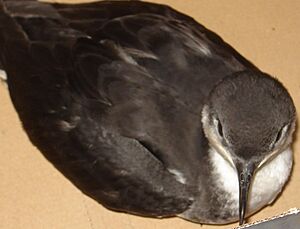
- Tropical shearwater, Puffinus bailloni – Breeds on the Mascarene Islands in the southwestern Indian Ocean. It lives throughout the southwestern Indian Ocean.
- Puffinus bailloni dichrous – Breeds across central Polynesia and possibly Melanesia in the Pacific. It also breeds in the northwestern Indian Ocean. This group is quite confusing because it lives in two areas far apart.
This group is now usually considered a separate species, the tropical shearwater.
Birds Still Being Studied
- Bannerman's shearwater, Puffinus lherminieri bannermani – Breeds on the Ogasawara Islands in the northwestern Pacific. It lives throughout the northwestern Pacific.
- Puffinus bailloni gunax – Breeds on the Banks Islands of Vanuatu in the southwestern Pacific. It lives throughout the southwestern Pacific.
Scientists need more information to fully understand these birds. The case of gunax seems simpler; it likely belongs to the bailloni group. The case of bannermani is more complex. It has been suggested as its own species, Bannerman's shearwater. Its exact status is still being worked out.
The Heinroth's shearwater is another little-known bird. Its relationships are still unclear because scientists do not have enough samples to study it properly.



